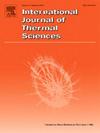Comparative analysis of phase-change coolants on heat and mass transfer characteristics in nose cone transpiration cooling
IF 4.9
2区 工程技术
Q1 ENGINEERING, MECHANICAL
International Journal of Thermal Sciences
Pub Date : 2025-07-09
DOI:10.1016/j.ijthermalsci.2025.110129
引用次数: 0
Abstract
Phase-change transpiration cooling technology presents significant potential for hypersonic thermal protection. Extensive investigations of water-based transpiration cooling systems have shown their susceptibility to instability under certain operating conditions. Therefore, there is an urgent need to conduct comparative studies of alternative coolants for nose cone transpiration cooling. In this study, a mathematical model coupling the finite-rate chemical reaction external field with the two-phase mixed porous internal field is constructed, using the partitioned modeling technique and interface coupling algorithm. Simulations under different Mach numbers and static pressures reveal the heat and mass transfer characteristics between ethanol and water coolant. The results show that the thermodynamic and transport properties of the working fluids significantly affect the bow shock, the injected thermal barrier layer, and the distribution of the energy and flow fields inside the nose cone. Under high Mach number conditions, ethanol proves ineffective in mitigating the extreme aerodynamic heat load, leading to heat transfer deterioration in the stagnation region. In contrast, under low heat load conditions, ethanol exhibits better flow and heat transfer synergy, with a 45 % improvement in the uniformity of mass injection distribution. These findings provide a valuable reference for the selection of coolant in nose cone transpiration cooling systems.
相变冷却剂对鼻锥蒸腾冷却传热传质特性的比较分析
相变蒸腾冷却技术在高超声速热防护中具有重要的潜力。对水基蒸腾冷却系统的广泛研究表明,在某些操作条件下,水基蒸腾冷却系统易失稳。因此,迫切需要对鼻锥蒸腾冷却的替代冷却剂进行比较研究。本文采用分区建模技术和界面耦合算法,建立了有限速率化学反应外场与两相混合多孔内场耦合的数学模型。不同马赫数和静压力下的模拟实验揭示了乙醇与水冷剂之间的传热传质特性。结果表明,工质的热力学性质和输运性质对艏激波、注入热障层以及机头锥内能量场和流场分布有显著影响。在高马赫数条件下,乙醇对缓解极端气动热负荷无效,导致滞止区传热恶化。相比之下,在低热负荷条件下,乙醇表现出更好的流动和传热协同作用,质量喷射分布均匀性提高了45%。研究结果为机头锥蒸腾冷却系统冷却剂的选择提供了有价值的参考。
本文章由计算机程序翻译,如有差异,请以英文原文为准。
求助全文
约1分钟内获得全文
求助全文
来源期刊

International Journal of Thermal Sciences
工程技术-工程:机械
CiteScore
8.10
自引率
11.10%
发文量
531
审稿时长
55 days
期刊介绍:
The International Journal of Thermal Sciences is a journal devoted to the publication of fundamental studies on the physics of transfer processes in general, with an emphasis on thermal aspects and also applied research on various processes, energy systems and the environment. Articles are published in English and French, and are subject to peer review.
The fundamental subjects considered within the scope of the journal are:
* Heat and relevant mass transfer at all scales (nano, micro and macro) and in all types of material (heterogeneous, composites, biological,...) and fluid flow
* Forced, natural or mixed convection in reactive or non-reactive media
* Single or multi–phase fluid flow with or without phase change
* Near–and far–field radiative heat transfer
* Combined modes of heat transfer in complex systems (for example, plasmas, biological, geological,...)
* Multiscale modelling
The applied research topics include:
* Heat exchangers, heat pipes, cooling processes
* Transport phenomena taking place in industrial processes (chemical, food and agricultural, metallurgical, space and aeronautical, automobile industries)
* Nano–and micro–technology for energy, space, biosystems and devices
* Heat transport analysis in advanced systems
* Impact of energy–related processes on environment, and emerging energy systems
The study of thermophysical properties of materials and fluids, thermal measurement techniques, inverse methods, and the developments of experimental methods are within the scope of the International Journal of Thermal Sciences which also covers the modelling, and numerical methods applied to thermal transfer.
 求助内容:
求助内容: 应助结果提醒方式:
应助结果提醒方式:


